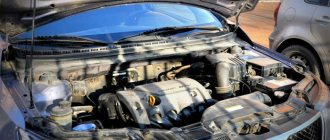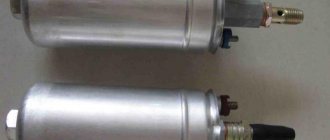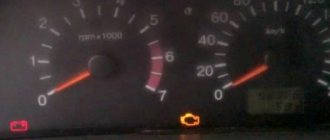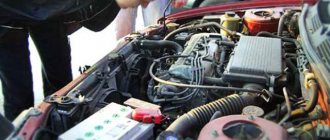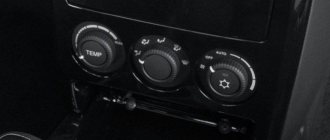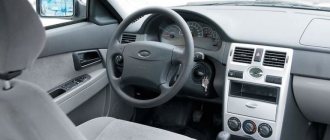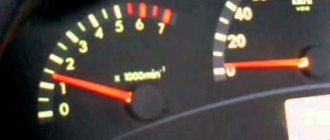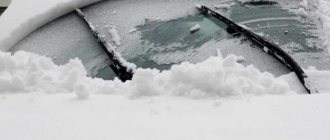Have you encountered engine problems when the car stalls in traffic jams or the engine speed is unstable? There may be several reasons for these malfunctions. It is recommended to start searching for a problem with diagnostics, and if this is not possible, then first perform a check, and only then change the faulty parts.
AvtoVAZ installs the same type of engines on modern Lada cars (Kalina, Granta, Priora, Largus, Vesta, Niva or XRAY), so the solution to problems for all these cars is similar.
The idle speed fluctuates, the engine stalls when moving (on the move) or at a standstill, the reasons may be the following:
- The engine air filter is clogged.
- The spark plugs are faulty.
- High voltage wires are faulty.
- Ignition module/coils are faulty.
- The idle air control (IAC) or its electrical circuits are faulty.
- The throttle position sensor (TPS) is faulty or the throttle assembly is dirty.
- The mass air flow sensor (MAF) is not working.
- The oxygen sensor (OS) or circuits are faulty.
- There is insufficient pressure in the fuel rail.
- Compression in the cylinders is low.
- The exhaust system is leaking.
- Air leaks through the crankcase ventilation hoses and the hose connecting the intake pipe to the vacuum brake booster.
- The cylinder head gasket is damaged.
- The timing belt or tension roller is worn.
- The camshaft cams are worn.
- The valve timing is off. Check the alignment of the marks on the crankshaft and camshaft.
- The engine control unit (ECU) or its circuits are faulty.
Have you encountered floating engine speeds? What was the cause of the malfunction? We solve such engine problems in the comments or on the forum. Let us remind you that along with unstable speed there may be other problems, for example, the engine is difficult to start.
Priora stalls while driving
Often a Priora car may have this type of malfunction when the car stalls while driving.
Previously, it was believed that this problem mainly affected domestically produced cars, but it turns out that many foreign cars “suffer” from the same problem. But, let's talk about the Priora car, the malfunction can manifest itself like this: the car starts up, it accelerates well, but when you remove the gas pedal, the revolutions begin to fluctuate, the engine rattles, that is, its speed level changes all the time, although the tachometer arrow should point to 1000 revolutions. After a while the car stalls. If you start it, everything will repeat itself. What to do in this case? Let's try to break down the main points so we can easily fix the problem.
Oil
Many car owners try to change their oil before winter. But not everyone knows that the oil with the lowest viscosity is best suited for winter. Thick oil will simply harden in winter. In addition, when the engine is cold, it is very difficult for it to drive thick oil through the channels. If the picture is complemented by an old battery, then this aggravates the situation even more. Therefore, you need to try to purchase oil of exactly the viscosity at which the engine can start normally even in cold weather. Typically, a product with a viscosity of 5W30 is purchased. But in any case, you need to look at the manufacturer's recommendations. You should not deviate significantly from the tolerances.
If the Priora stalls while driving, there may be the following reasons:
— the first is the idle speed sensor. It should keep the car idling while starting the engine. If the Priora stalls at idle or the car does not start (the starter turns the engine), you can easily check what is causing this: if the car does not start, then you need to lightly press the gas pedal, in which case the car should start.
But if you take your foot off the gas pedal, the revs begin to fluctuate, and then the car stalls. This is typical for idle speed sensors (IAC). It should be changed. This is quite easy to do on Priora. Experts note this cause of failure as the most likely.
— the reason that the Priora stalls while driving may also be that the throttle valve in the car is clogged. In this case, the idle speed of the engine will float and the car may stall. With this type of malfunction, it is enough to clean the throttle valve.
— if the Priora stalls while driving, there is a possibility that the throttle position sensor (TPS) has become unusable. It should be replaced only after cleaning the throttle valve itself. This is located next to the XX sensor. It changes very quickly.
Here are the main reasons why the Priora stalls at idle. In this case, experts recommend changing two sensors at once: throttle position and idle speed. But this should be done only after you have cleaned the damper itself.
After this, the car should work as before. Such breakdowns are quite easy to fix. You can try to figure it out yourself or entrust your car to specialists so that the breakdown can be repaired professionally and without unnecessary hassle.
The car does not start due to insufficient crankshaft speed
The primary reason why a car may have difficulty starting when cold is poor crankshaft movement. When you try to activate the motor, it may rotate too slowly, which is why the crankshaft simply does not reach the required starting frequency. The standard starting frequency for starting the motor is approximately 40-50 rpm. If you notice that the crankshaft is not rotating fast enough, the reasons for this are the following:
- Insufficient battery charge.
- Solidification of engine oil.
The solution to the problem is based on the cause of the problem. If you leave your battery in your car in the cold, draining it may be the best possible outcome.
As for motor oil, this is a common mistake made by novice car enthusiasts. I bought the car in the summer, with summer oil, and even mineral oil, but did not drain it before the frost. So it freezes, and quite quickly. If you are faced with such a problem, there is nothing you can do. There is a temporary solution, but it is quite dangerous. You need to pour a little gasoline into the oil filler neck and crank the crankshaft with the starter several times, and then leave the car for 24 hours. The oil will become less thick, but in this case you will soon have to change:
Therefore, immediate advice for novice car enthusiasts: with the onset of frost, drain the mineral oil from the engine. The sooner you do this, the lower the risk of a problem occurring. Experienced drivers advise using semi-synthetics for the winter, which can withstand much lower temperatures.
A little about the reasons
The Lada Priora stalls while driving when releasing gas: the causes of this malfunction most often are a violation of the composition of the fuel mixture entering the car’s engine.
Having analyzed the methods of car owners of this car model to eliminate this malfunction, we can conclude that such a violation may be caused by improper operation of both the throttle system and some sensors and regulators. A complete diagnosis of the car at a car service center will help to identify the specific reason for the “floating” idle speed, although sometimes it is possible to find the source of the engine’s malfunction on your own. To do this, you need to sequentially disconnect or replace the following sensors and regulators with ones that are known to work correctly, removed from another vehicle.
So, let's figure out what to do first in case of such a malfunction.
Important: checking sensors
The answer to the question why the idle speed on a Priora fluctuates can often be this: one of the three sensors (IAC, TPS, MAF) is faulty. It's quite easy to check:
- Start the power plant.
- Disconnect the IAC power supply and analyze: the IAC frequency remains the same or the motor stalls - the sensor needs to be replaced. If the frequency has increased, the sensor is working.
- Restore power to the regulator.
- Remove the chip from the mass air flow sensor and observe: the speed has increased - the mass air flow sensor is working; the engine has stalled - the mass air flow sensor should be replaced.
- Connect power to the TPS.
- Disconnect the block from the mass air flow sensor and analyze: the crankshaft rotation speed has increased - the mass air flow sensor is working, the engine stalls - the throttle position sensor is faulty.
- Attach the chip to the mass air flow sensor.
For your information. Often the problem is caused by a poor connection of the terminals of both the “negative” and “positive” wires.
Checking the operation of the throttle valve
Very often, the cause of idle “floating” is a malfunction of the throttle position sensor (TPS). The graphite track inside a standardly installed part wears out over time, so it is replaced with a sensor with a non-contact system. After replacement, you need to reset the sensor error. To do this, disconnect the terminals from the battery for 30 seconds or more.
It is also necessary to check the cleanliness and integrity of the pipe leading from the air filter to the throttle valve, and adjust the tension of the gas pedal cable going to it.
It is also possible that the gasket of the throttle assembly has become unusable or the assembly itself needs to be thoroughly cleaned (motor oil could have gotten into it) with special compounds for washing carburetors.
Changing the idle air control
Car service specialists admit that sometimes they have to spend a long time selecting a correctly working (despite the fact that it is new) idle air regulator to stabilize the idle speed of the engine. It is in this case that, before handing over your car for service, you should use an IAC regulator removed (temporarily) from a working car of the same brand.
It is advisable to replace the idle air regulator itself in conjunction with cleaning the vehicle's throttle system.
Other reasons
In addition to the above malfunctions, Priora car owners resort to the following types of repairs to their car aimed at eliminating idle “floating”:
- replacing the knock sensor (DS) or crankshaft sensor;
- cleaning the speed sensor (DS), fuel grid or fuel filter;
- checking the integrity of the wires suitable for the sensors and the cleanliness of their terminals;
- adjusting fuel pressure or the operation of the vehicle's air intake system;
- increasing the power of the electric generator by adding another diode to its circuit;
- change the voltage regulator;
- adjust the correct operation of the absorber valve;
- check the carbon dioxide content in the fuel mixture and the correct functioning of the oxygen sensor (lambda), or turn it off programmatically;
- Reset the vehicle's electronic control unit (ECU). To do this, the battery is disconnected for a while, and then, after connecting it, the electronic system is “self-learning”;
- perform flashing of the car's electronic system.
In general, such a situation can arise even due to poor quality of the fuel being poured. In addition to changing the gas station, the fuel system may need to be cleaned.
The situation when the Lada Priora stalls while driving when releasing the gas can arise either for one of the above reasons or for a combination of them. Therefore, before purchasing new parts (to avoid unnecessary costs), it is recommended to diagnose the operation of the vehicle system at a car service center.
How to stabilize floating speed
- Penetration of foreign air into the engine. It is necessary to check the tightness of the air system channels with the intake manifold. For such purposes, it is necessary to dismantle each hose separately and pump it with a pump or compressor, but you can try spraying liquid -40 on the hoses, where it will quickly evaporate; there is most likely a crack in the hose. In such a situation, it is better to replace the damaged hose with a new one rather than wrap it with electrical tape.
- Replacement of IAC. The condition of this device is checked with a conventional multimeter, which needs to check its resistance. If the resistance readings are in the range of 40-80 Ohms, the regulator is faulty and such a device requires immediate replacement.
- Cleaning the valve and elements of the engine ventilation system. In this case, you will have to disassemble the oil sump and get to the ventilation valve. It should be pulled out and washed in a product for cleaning engine elements from an oil film. You can use regular kerosene. Next, dry the valve thoroughly and then put it in its place.
- Replacing the air flow sensor. This is the most delicate part and most often cannot be repaired. Therefore, if the cause is the air flow sensor, then it is advisable to replace it. It is known from practice that even professionals cannot repair a hot-wire anemometer.
- Flushing the throttle valve and then installing it in the correct position. There are two methods for cleaning the throttle valve from oil contaminants: without removing it from the car, and also with removing the throttle valve. When removing the damper from the car, you must disconnect all wires and hoses from the damper, loosen it and pull it out. Next, place it in a container and fill it with cleaning aerosol. If the oil stains on the surface of the throttle valve are already old, you can clean them with a brush. Next, dry the damper surfaces with a rag and put them in place, connecting all the wires and hoses. If the damper is not removed from the car, then it can be washed on a hot power unit with a similar aerosol. Before spraying cleaning agent, disconnect power from the throttle valve. First you need to pour the product inside the throttle valve, wait a few minutes and start the engine. With the power unit operating, continue cleaning the damper with the same product. If, during such cleaning, white smoke comes from the damper, then this is normal, since oil contaminants are cleaned in this way. At the end of the work, you should connect the wires and adjust the operating order of the throttle valve on the computer, setting the required opening gap.
- Idle speed adjustment. This procedure can be carried out using a regular screwdriver, adjusting the screws for the quality of the fuel mixture and the number of engine revolutions.
- Replacing the solenoid valve. If the carburetor idle valve malfunctions, the engine can only operate when the choke handle is pulled out. Therefore, in order to prevent idle speed fluctuations, it is advisable to replace the valve with a known good one or a new one.
- Cleaning the idle air jet. Even in the old days, cleaning the jet from oil deposits was considered a very labor-intensive task. Currently there is no need to remove the jet from the carburetor. To do this, you just need to pour a specialized product into it, designed for cleaning carburetors, and wait in this state for several minutes. Then you need to clean the nozzle from dirt using compressed air.
- Treatment of parts of the fuel pump on a diesel engine from rust. To perform this task, you will need a specialized corrosion cleaning agent. This can be either an imported or a domestic product. It is simply sprayed into the fuel tank by opening its neck before refueling with diesel fuel at a gas station. The cleaning agent will clean the pump parts from rust on its own. In order to prevent similar corrosion of the high-pressure pump in the future, it is recommended to pour a glass of motor oil into the tank, which can form a protective film on the surface of the pump parts when moving.
We recommend: Non-contact ignition system (BSI)
You need to know that if uneven engine speed occurs at idle, you must immediately contact a service station and carry out detailed diagnostics of the operation of all engine systems. Timely detection of faults will protect you from costly repairs.
Priora stalls at idle
Hello! Please help me with advice, this is the problem, I’ll write everything in detail:
For the last 3 months I have been refueling exclusively at a gas station near my house, not out of principle, but it just happened that way. Once, maybe a month and a half ago, I refueled at a Gazprom gas station in another area, since there was little gas in the tank, while driving home, strange things began to happen to the car, it began to stall at all traffic lights, when I was in neutral, it started sometimes the first time, sometimes the third time. In general, I somehow got home, talked with friends, decided that the gasoline they filled up was bad, swore at Gazprom and decided to see what would happen after I used up this gasoline and filled up with new ones. As a result, I ran out of this tank, the car periodically stalled, precisely at traffic lights or when I started to park, but if I drove more than 20 km/h, then it seemed to be normal.
Then I refueled again at my home gas station and forgot about this problem. I drove on and didn’t know any trouble. And a couple of days ago I needed to go to the airport early in the morning. There wasn’t enough gasoline - I wanted to refuel where I always do, but the gas station wasn’t open 24 hours a day, so I ended up refueling at BP on the Moscow Ring Road and got to the airport without any problems. When I started driving back, the car stalled 5 times when leaving the parking lot, then it periodically stalled on the Moscow Ring Road, if the gas pedal is released even at a speed of 100 km/h, the revolutions begin to jump and the car jerks. Finally, I got home, parked, and now I can’t start it at all, it stalls instantly! If I hold down the gas pedal during the factory, it does not stall, as soon as I release it, it stalls. I held the gas pedal for a couple of minutes - I released it, the engine ran for 2 minutes, then it stalled, then the same thing.
I asked my friends and looked for answers on the Internet. As I understand it, there is a problem with the fuel system or spark plugs. I changed the fuel filter a month ago (I drove 2000 km), I bought new spark plugs today and installed them, but it didn’t help. They say it might also be possible to clean the injector, but no one really knows, and now I can’t get to the service center. It can’t be that the gasoline was terrible both times. Please advise, has anyone had a similar problem? Thank you in advance!
Priora stalls while driving
VAZ (Lada) Priora 2007 - present
Priora, 2010, hatchback. It stalls while driving at any speed. And then I remove the terminal from the battery and put it back. I put it in and everything starts up fine. Sometimes the instrument panel turns off as if it was frozen and I do the same, remove the terminal, etc. I don’t know what kind of glitches this is? Can someone tell me?
- Dips when pressing the gas in Lada Priora - 3 answers
- Engine shutdown at idle, VAZ Priora – 3 answers
- Why did error codes appear on Priora? – 1 answer
- Error p1602 in Priora - 1 answer
- Error 4 on the instrument panel display, VAZ Priora – 11 answers
And when it stalls, the panel does not go out? If the terminal is not removed, the starter turns, but the engine does not start? Is the check light on? Check the cleanliness of the battery terminals and ground. You also need to carry out diagnostics with a scanner, read the errors and carry out a series of checks on them.
When you remove the battery terminal, the errors in the ECU memory are erased, but apparently they are there. The error codes will help determine the malfunction. Also check the ECU connector (remove/install).
You apparently have a weak wire connection at the battery terminal. You move it, put it in place, and contact appears. Then, while driving, the wire becomes loose and weakens to the point that the power even disappears completely - the instrument panel goes out. You move the wires again, contact is restored and the motor starts. Inspect and check the wire that you remove from the battery to see if the contact is reliable. And when installing it on the battery terminal, be sure to tighten it with a bolt.
- The second cylinder does not work when cold in the Lada Priora - 3 answers
- How to close the gap between the canopy and the fender in a Lada Priora? – 1 answer
- What kind of carbon deposits are there on the spark plugs of Lada Priora? – 3 answers
- Rear suspension knocking in Lada Priora - 3 answers
- Error P0485 in Lada Priora - 1 answer
- Lada Priora has trouble starting when warm after 5 minutes of inactivity - 1 answer
- Is it possible to install a BMW dashboard on a Priora? – 1 answer
- The mark on the exhaust camshaft gear in Priora is displaced - 2 answers
- Which timing kit is better to install on Lada Priora? – 1 answer
- Noise in the gearbox when pressing the clutch of Lada Priora? – 2 answers
Subscribe
to our channel in
Index.Zen
Even more useful tips in a convenient format
Why did error codes appear on Priora?
Engine shutdown at idle, VAZ Priora
Lada Priora Sedan 2009, 98 l. With. - observation
Lada Priora, 2012
Comments 34
My revs are fluctuating, I’ve already tried everything and nothing helps, but when I decided to just pull the gas pedal slightly towards myself, the revs returned to normal and everything is ok, apparently there’s a problem with the throttle cable, I’ll try to tighten it.
Priora 2014, 106 thousand mileage, 16kL engine. 127, 106hp, air conditioning, abs. There is a gas injector (distribution) of the latest generation. The whole point is that at idle speed on a warm engine the speed fluctuates up to 1000, (precisely on a warm one) and on gasoline this is not so pronounced, practically not noticeable and a rare phenomenon, although it gives Sometimes you know about yourself, sometimes you increase the speed, release the pedal, it disappears, but as for the gas, things are already the other way around. Before this, the check light was on, diagnostics showed a malfunction of the throttle mechanism, I thought it was the problem, I bought a new one, changed it, and retrained it. As soon as I got home, the revs started to pick up again. What could be the reason, has anyone encountered it?
Hello, you described my problem))) did you solve it?)
Need advice. The cylinders turn off and whatever one wants, it doesn’t matter the first or the third or two at once, the error shows gaps in the protection. I changed everything I could, coils, filters, fuel pump assembly, crankshaft sensor, they didn’t give a damn. I changed all the spark plugs passed but not for long at 1000 km. I washed the throttle and already took everything apart. Priora 2 2015 Guards
The same problem after removing the intake manifold injectors on xx Jackie Chan is generally gesticulating and yelling error 0101, they have already moved everything again, checked the spark plugs and changed them. Misfires, increased consumption of air flow sensor, changed and don’t know where to dig next
The same problem, only the speed fluctuates when hot from 1000 to 2000 thousand
Please tell me, the speed fluctuates and it eats a lot, when you take out the chip from the DTOZh the speed returns to normal and the fan turns on, I put the chip back in, the speed is normal and it eats a little, after a while everything is the same again. Does anyone know what kind of miracles this is?
All your problems start from the catalyst, because it is the catalyst that determines whether the fuel has burned out and begins to regulate the system. A new one costs from 3 to 8 thousand rubles. and with our quality of fuel they go down the drain very quickly. So don’t even doubt it and go ahead. After the firmware, your euro level will drop (it all depends on the firmware), but I can say one thing: if the firmware is good, the engine will only be pleased.
Symptoms: Accelerated engine warm-up Speeds float at xx Acceleration response decreases There have been cases where consumption decreased (decently)
Don’t forget to ask the technician to set the temperature threshold of the first fan mode (if you have 2 of them) to 99℃ (from the factory 103℃), but if the technician is normal, he will do it himself or suggest it to you.
I have a 2007 Priora, I bought it half a year ago, the revs fluctuated, the car sometimes stalled when switched to neutral. I changed the throttle sensor and IAC, washed the throttle body. Now, when starting a cold engine, the revolutions jump from 1200 to 1900. I went for diagnostics and there were no errors. They told me to change the adsorber valve, but the valve is working. Maybe someone has encountered such a problem?
Have you encountered engine problems when the car stalls in traffic jams or the engine speed is unstable? There may be several reasons for these malfunctions. It is recommended to start searching for a problem with diagnostics, and if this is not possible, then first perform a check, and only then change the faulty parts.
AvtoVAZ installs the same type of engines on modern Lada cars (Kalina, Granta, Priora, Largus, Vesta, Niva or XRAY), so the solution to problems for all these cars is similar.
The idle speed fluctuates, the engine stalls when moving (on the move) or at a standstill, the reasons may be the following:
- The engine air filter is clogged.
- The spark plugs are faulty.
- High voltage wires are faulty.
- Ignition module/coils are faulty.
- The idle air control (IAC) or its electrical circuits are faulty.
- The throttle position sensor (TPS) is faulty or the throttle assembly is dirty.
- The mass air flow sensor (MAF) is not working.
- The oxygen sensor (OS) or circuits are faulty.
- There is insufficient pressure in the fuel rail.
- Compression in the cylinders is low.
- The exhaust system is leaking.
- Air leaks through the crankcase ventilation hoses and the hose connecting the intake pipe to the vacuum brake booster.
- The cylinder head gasket is damaged.
- The timing belt or tension roller is worn.
- The camshaft cams are worn.
- The valve timing is off. Check the alignment of the marks on the crankshaft and camshaft.
- The engine control unit (ECU) or its circuits are faulty.
The cause of a stalled engine is the spark plugs
In 50% of cases, the problem is due to the fact that the spark plugs simply do not produce a spark. This failure occurs as a result of 3 reasons:
- contacts become clogged;
- plaque forms along the entire contour of the candle;
- malfunction when supplying voltage to the spark plug.
However, the most popular is still black carbon deposits on the spark plugs, which prevents the spark from appearing or causes it to work periodically.
Tip: if the spark plug set malfunctions, you will hear a “triple” sound that is uncharacteristic of the engine. In this case, the car will jerk strongly while moving. As a result, the engine will either stall on its own, or you will need to turn it off and turn the ignition on again.
If you see dirt on the surface of the contacts, this indicates the need to replace a low-quality type of fuel or check the serviceability of the oil supply systems. It is the oil supply adjustment sensors that can splash the spark plugs with it if there is a problem. Also, oil that appears on a set of spark plugs may indicate serious damage to components in the engine cylinders. Be sure to check the engine at a car service center. Otherwise, further operation may lead to expensive replacement of jet rods and even the entire set of pistons.
If you systematically use low-quality gasoline samples, you may find a red-brown coating on the contour of the spark plug. In this case, cleaning will not help - it is better to immediately replace the entire set after a new refill. If you find that the car periodically turns off at full speed, but starts easily even with clean spark plugs, then the problem lies in the electrical wiring.
Correct engine diagnostics
Most often, the malfunction can be determined using engine diagnostics
. First, you need to contact diagnostic specialists so that they connect the tester and read possible fault codes on the car. Most brands and models of modern cars make it possible, by reading error codes, to draw a conclusion about what needs to be changed in the engine or in some other units.
Engine diagnostics using a tester makes it possible to check not only permanent errors and understand what is broken in the engine, but also to read the so-called short-term faults accumulated in the memory of electrical control units.
If engine diagnostics did not bring the desired result and it is not possible to find the fault in this way, then you should continue checking, starting from the most obvious breakdowns and ending with the less obvious ones.
Timely replacement of spark plugs
The very first thing the technician should do is unscrew and check the spark plugs. It is no secret that replacing spark plugs is most often recommended for car owners if the described problems with the engine begin. Before replacing spark plugs with new ones
, it is better to check them not only visually, but also install them on a special stand. The fact is that at first glance, the spark plug may look completely serviceable, but in fact, the spark does not jump between the electrodes, as it should be, but walks along the entire base of the base and can only be seen on the stand through the viewing window. In addition, air is pumped out of the chamber where the spark plugs are tested, which creates a simulation of the combustion chamber just before the fuel ignites.
Replacing spark plugs, the cheapest repair at floating speeds
. In any case, we always recommend that customers check the spark plugs every maintenance, and since they are removed from the engine, you can also check the compression, because floating speed and engine tripping can occur, for example, due to burnt-out valves and stuck rings.
Preventive replacement of high-voltage wires
Replacing high-voltage wires is also not very expensive
and this is also one of the most obvious malfunctions at floating speeds. You can determine that high-voltage wires require replacement yourself. It is enough to wait until it is dark and in the dark to see if breakdowns occur on the motor housing from the wiring. This is very clearly visible.
It’s another matter when there are no high-voltage wires on the car; by definition, the ignition coil is installed directly on the spark plug. In these cases, breakdowns to ground may occur due to dried or cracked rubber caps that go from the coil to the spark plug. Such breakdowns are diagnosed by replacing the coils, which we will write about below.
The cause of a stalled engine is a power supply failure
In this type of problem, 3 reasons may be involved:
- Poor contact with the terminals of the new battery;
- Detection of poor contact or breakdown along the entire length of high-voltage wires;
- The appearance of malfunctions in the generator or ignition coil system of the car.
If the problem lies in damp high-voltage wires, then it is best to replace them completely along with the battery contacts. If the terminals make poor contact, you need to carefully clean them with sandpaper and try to reconnect them. If the generator is found to be inoperable, the problem usually boils down to problems in the following parts:
- Broken timing belt;
- There is a malfunction inside the housing of the unit itself.
A problem with the generator is easily detected when the corresponding indicator on the dashboard turns on. In addition, if there is insufficient energy supply, the backlight of the on-board panel will gradually fade, and a set of other diagnostic sensors will show incorrect values.
Advice: if when you press the gas the car jerks, then stalls and cannot start, then the problem is related to the failure of the ignition coils. It is best to replace these parts in a car service using special equipment.
From the list of reasons that are directly related to the car engine, you need to move on to problems that arise in the fuel and air supply systems, as well as malfunctions of components responsible for exhaust gas removal.
Fuel pump is faulty
A fuel pump malfunction may be caused by oxidation of the wires in the connector. The power supply to the fuel pump is unstable, and, as a result, fuel is simply not supplied to the engine. This can be fixed by simply cleaning the contacts. There may also be a problem with the pump itself. Nothing lasts forever, and it can fail. But the most common fuel pump malfunction is contamination of the primary strainer. There is no point in washing it; it is better to buy a new one and replace it.
In this article, we looked at the most common reasons for the engine stopping while driving. If the information presented in the article does not help solve the problem, we strongly recommend that you contact a car service center.
Fuel supply faults
It is quite easy to find out that the car stalls while driving due to the engine being “choked” with the fuel mixture - during a long drive you will find that the signal of the sensor responsible for this function is constantly on.
Here the problem lies in low-quality fuel, which does not quickly “ignite” from the spark of the candles. It can also be caused by gasoline not meeting the requirements for the octane number specified in the vehicle specifications. If there are problems with fuel, the gas pedal will be pressed all the way, and the car will not begin to gain speed. In addition, the car will periodically stall when the clutch is engaged.
Another symptom indicating problems with fuel is the appearance of problems with the car after refueling. The problem is characterized by a rapid drop in engine power at full speed, as well as when constantly changing gears. The way out of the situation is to completely drain the bad fuel mixture, wash the engine and all the fuel system pipes.
Also, the car will constantly stall if there is an interruption in the supply of the fuel mixture. This may be due to contamination in the following system components:
- Dirt in the fuel filter;
- Problems with injector nozzles;
- Dirty throttle valves;
- Fuel pump power failure.
The main symptom of a malfunction of these parts is that there will be a gradual drop in the power of the car’s engine, after which the car will stall even after sharply pressing the gas pedal. If you do not release the clutch carefully when changing gears, this will also cause the engine to stall.
The contamination of the fuel filter and fuel pump can be judged by the unstable operation of the machine even during idling and during rapid braking (when the supply of the fuel mixture decreases). And if the performance of fuel filters can be easily established during an external inspection and eliminated by replacing them, then to detect other causes, you need a full-fledged computer diagnostics, which can only be carried out in a car service center.
Another reason for a stalled car associated with the operation of the fuel pump is boiling gasoline in the fuel pump. This happens mainly in hot weather when the car is moving slowly or standing on the highway in traffic jams. The car will start to stall while driving, but when you turn on the idle speed and press the clutch, it will start again.
If boiling occurs, it is better to stand in a traffic jam with the engine turned off and gradually cool the car. After 5-10 minutes, the car's operation will be stable again.
Advice: if you recently did a wheel alignment with your own hands on a VAZ-2107, then to cool the car, proceed as follows - throw a piece of cloth made of dense material over the fuel pump body, which you first moisten with cold water.
The speed drops after releasing the gas on a VAZ 2114: what's the matter?
Compared to the previous carburetor generation, the new injection VAZ 2114 turned out to be much more efficient and reliable, but from time to time they are plagued by various problems. A situation such as a drop in speed after releasing the gas on a VAZ 2114 is almost always caused by problems with the injection system, but other causes must be excluded during the diagnostic process.
How to find the cause of the problem
[flat_ab id=”3"]
If the speed of the VAZ 2114 drops, you need to comprehensively diagnose the functioning of the injection system on your car, which can be done in your garage if you have a little experience and appropriate instructions.
In this case, those “fourteeners” that were equipped from the factory with a dashboard from the German manufacturer VDO have an important advantage, since it, in comparison with the analogue from Schetmash, is equipped with a self-diagnosis mode.
VDO dashboard for VAZ 2114
To carry out this procedure, you will need to perform a few simple steps:
- After turning off the engine, you need to keep the odometer button pressed for three to five seconds;
- Having turned the engine ignition to the first position, the button must be released;
- arrows should appear on the display, which is a signal of normal operation, then the button must be pressed the first time (displaying the firmware version) and the second time - after this probable errors in the ECU will be shown;
- To reset the error message, you will need to hold the button until a zero appears on the display.
After reading the manual, you can find out what errors shown on the screen may be associated with the fact that the speed constantly drops when the gas is released on the VAZ 2114.
So, it could be one of the following situations:
- code 1 – controller error;
- code 14/15 – coolant sensor error;
- code 22/23 – throttle position sensor error;
- code 33/34 – mass air flow sensor error;
- code 42 – faulty ignition;
- code 44 – fuel mixture is lean or too rich.
The owner of a VAZ 2114 should remember a specific feature of the self-diagnosis mode on his car: if there are several errors, the computer sums their codes arithmetically, which can be misleading. This can be indicated by a logical discrepancy between the displayed code and the actual problems.
To be completely sure, you will either need to take the car to a service center and pay for its inspection, or buy a diagnostic scanner yourself, which is not that expensive. Another option is if you have the same VAZ model (fully operational), one by one, remove it from it and install potentially vulnerable sensors on your car, using the method of elimination to find the problem.
Finding a breakdown without using the on-board controller
External “symptoms” of the behavior of a car and, in particular, its engine can also give a lot of food for thought to an experienced and observant driver. By analyzing these factors, you can significantly reduce the list of probable causes of the problem.
- For example, it is necessary to track the moment the engine randomly turns off - at idle, during a “cold” start, after the engine has warmed up to a specific temperature, or when the gas pedal is sharply pressed.
- In addition, you should pay attention to whether the speed drops with constant throttle application, and how the engine behaves when braking, releasing the gas pedal and turning off the gear?
- Along with visual and auditory diagnostics, it would be useful to check in a circle potentially vulnerable components that could lead to the VAZ 2114 stalling when releasing the gas.
- Firstly, you should start by checking the fuel and air filters - it is recommended to change them every 30 thousand kilometers, but in fact, operating conditions and the quality of the filters lead to the fact that in order to avoid problems it is better to halve this period (especially since in cars with With longer mileage, filters become clogged even faster).
Replacing the fuel filter VAZ 2114
In addition, you definitely need to check the fuel level in the tank, no matter how funny it may sound: the fuel level sensor often deceives the driver, and in addition, the car may simply be parked on a slope, which is why the fuel pump simply does not supply fuel to the engine - hence reason for the drop in speed.
A very common situation is the appearance of problems with ignition or maintaining speed after minor independent repairs: in this case, you need to check all the chips, contacts, terminals and wiring again to eliminate the usual human factor.
RPM drop in neutral gear
If the speed of a VAZ 2114 drops and the engine stalls when cold, there are not so many probable causes of the problem: a faulty fuel pump, a breakdown of the idle air control, a clogged injector or a malfunction of the coolant temperature sensor.
The main ways to solve encountered situations are as follows:
- If the reason is in the idle speed control, then the engine will constantly stall in this mode, and not just stall. To diagnose the IAC, you will need a multimeter, which measures the resistance with the engine turned off: at terminals A – B, C – D it should be approximately 54 Ohms, while between the pairs it will be equal to infinity. Any deviation from these indicators should be considered a malfunction.
- A dirty injector is a very common situation, considering how low-quality gasoline is sold at most gas stations: sometimes using a special injector cleaning agent can help. It’s worse when the injectors are clogged - if the cleaning products don’t help, you’ll have to change them or take them to a service center for cleaning.
- Failure of a fuel pump is usually preceded by characteristic signs of disturbances in its functioning: an attentive driver will hear a difference in the sound of the pump when starting the engine long before the breakdown. If the problem with the engine stalling does not occur when driving in gear, but occurs at idle, you can first check the fine filter.
- Sometimes spark plugs can fail, which directly affects the operation of the entire ignition system, but regularly replacing them for preventive purposes prevents the problem from occurring in advance. Additionally, it is recommended to check the condition of the ignition coil.
Difference between new and old candle
Sensor malfunction
The normal functioning of the injection engine on the VAZ 2114 is ensured by the correct operation of four key sensors: throttle position, mass air flow, crankshaft position and coolant temperature.
Throttle position sensor VAZ 2114
The first of them - TPS - is responsible for the amount of gasoline supplied to the engine from the gas tank, and in some cases it can become clogged to the extent that the performance of its moving parts deteriorates. This breakdown is characterized by the engine stalling when changing gears - both when the gas is released and when the engine speed is reduced, if the damper does not open or close in time.
A faulty mass air flow sensor is more likely to lead to sharp drops in power and increased gas mileage, rather than to a stalled engine if it transmits incorrect incoming air readings to the ECU. This, in turn, leads to a leaner mixture supplied to the cylinders, which sometimes causes a drop in speed.
Mass air flow sensor VAZ 2114
As for the DTOZH, when it fails, usually the car stalls already on a warm engine due to distorted information from the sensor, while a faulty DPKV is a very rare situation in which the fuel injection phases are disrupted and the engine begins to throttle severely.
Source: https://VAZremont.com/padayut-oboroty-posle-sbrosa-gaza-na-vaz-2114
Malfunctions in the air mixture supply system
Here the problem lies either in a clogged air filter or in the failure of the regulator responsible for idling the car. In this case, your car will stall all the time when you gain speed or when you release the gas when you release the accelerator.
To solve the problem, remove and inspect the air filter. If there is serious contamination or chips, replace it. To diagnose and replace the idle speed regulator, you will need the help of qualified car service employees.
Car exhaust system problem
The engine may also stall if the tubes responsible for removing gases are malfunctioning. At full speed, the car will quickly begin to “choke”, and pressing the gas pedal completely stops the engine. Malfunctions in the operation of the exhaust pipe system in 90% of cases are caused by contamination and clogging of the muffler. However, the catalyst may also fail.
In the first case, carefully clean the muffler and remove foreign objects from there. If there are problems with the catalyst, conduct a complete diagnosis of the exhaust system and replace this element.
What to do if cars with automatic transmission stall?
If your vehicle has an automatic transmission, then the problem should be found in the electrical supply. If you abruptly switch from one gear to another, or while switching gears while braking, the settings may be distorted, and the on-board computer will receive a signal to turn off the engine.
Also, models with automatic transmission may stall due to malfunctions of the hydrodynamic transformers of the gearbox. This problem mainly manifests itself during acceleration and requires urgent intervention from car service specialists.
